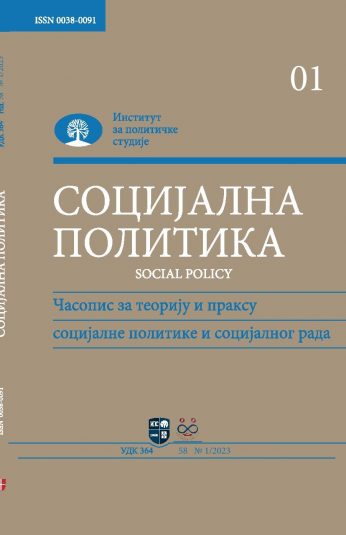Ћирић, З. и Димитријевић, Б. 2009. Основи судске психијатрије и судске психологије. Ниш: Студентски културни центар.
Даруши, Д. 2015. Наркокаријера у огледалу криминала. Нови Сад : Мултидизајн.
Димитријевић, Б. 2006. Личност малолетничке деликвенције. Годишњак за психологију, 4-5, 207-222.
Голубовић, Г., Лакић, А., и Илић, Б. 2002. Основи форензичке психологије и психопатологије. Бор: Здравствени центар Бор.
Гојковић, В. 2010. Породица и припадност криминалним групама као каузални криминогени фактори. Зборник Института за криминолошка и социолошка истраживања, 29, 167-192.
Хрнчић, Ј. 2007. Нека терминолошка разјашњења у области малолетничке деликвенције. Зборник Института за криминолошка и социолошка истраживања, 26, 183-202.
Хрнчић, Ј., и Џамоња – Игњатовић, Т. 2010. Оптимус – Обухватан приступ превенцији сукоба са законом код деце и младих. Зборник Института за криминолошка и социолошка истраживања, 29, 125-139.
Међедовић, Ј. 2010. Базична структура личности и психопатија: допринос дезинтеграције. Зборник Института за криминолошка и социолошка истраживања. 29, 7-29.
Међедовић, Ј. 2015. Номолошка мрежа психопатије. Београд: Институт за криминолошка и социолошка истраживања.
Момировић, К. и Поповић, Д. 2002. Психопатија и криминал. Лепосавић : Универзитет у Приштини, Центар за мултидисциплинарна истраживања Факултета за физичку културу.
Настасић, П. и Чекеравац, А. 2011. Принципи социјално-психолошког дијагностификовања акохолизма у социјалном раду. Факултет политичких наука, 6, 421-432.
Стевковић, Љ. 2007. Насилна виктимизација као фактор ризика за насилно криминално понашање малолетника. Зборник Института за криминолошка и социолошка истраживања, 26, 309-321.
Трбић, В, 2000. Опис алкохоличарске породице. Београд: Задужбина Андрејевић.
Ashton, M.C., Lee, K. & Son, C. 2000. Honesty as the sixth factor of personality: Correlations with Machiavellianisam, primary psychopathy and social adroitness. European Journal of Personality, 14, 359-368.
Ashton, М., Lee, К. and de Vries, R. 2014. The HEXACO Honesty-Humility, Аgreeableness, and Emotional Factors: A Review of Research and Theory. Personality and Social Psychology Review, 10, 1-14.
Cale, E.M. 2006. A quantitative review of the relations between the “Big 3” higher order personality dimensions and antisocial behavior. Journal of Research in Personality, 40, 250-284..
Costa Jr, P. T., & McCrae, R. R. 1992. Revised NEO Personality Inventory (NEO-PI-R) and the Five Factor Inventory (NEO-FFI): Professional Manual. Psychological Assessment Resources, Inc, Odessa, Florida.
Chabrol, H., Van Leeuwen, N., Rodgers, R., &Sejourne, S. 2009. Contributions of psychopathic, narcissistic, Machiavellian, and sadistic personality traits to juvenile delinquency. Personality and Individual Differences, 47, 734-739.
Daversa, M. T. 2010. Early environmental predictors of the affective and interpersonal constructs of psychopathy. International journal of offender therapy and comparative criminology, 54, 6-21.
De Vries, R.E., Lee, K., & Ashton, M.C. 2008.The Dutch HEXACO personality inventory: Psychometric properties, self-other agreement, and relations with psychopathy among low and high acquaintance ship dyads. Journal of Personality Assment, 90, 142-151.
De Vries, R., PhD, & Van Kampen, D. 2010. The HEXACO and 5DPT models of personality: A comparasion and their reationships with psychopathy, egoism, pretentiousness, immorality, and machiavellianism. Journal of Personality Disorders, 24, 244–257.
Frick, P. J., Кimonis, E. R., Dandreaux, D.M., &Farell, J. M. 2003. The 4 years stability of psychopathic traits in non-referred youth. Behavioral Sciences & the Law, 21, 713-736.
Hare, R.D. 1998. Psychopaths And their nature: Implications for the mental health and criminal justice systems. In T. Millon, E. Simonsen, M. Birket-Smith & R.D. Davis (eds.), Psychopathy: Antisocial, criminal and violent behavior. (p.p. 188-212). New York: Guilford.
Hare, R. D. 2003. The Hare Psychopathy Checklist—Revised (2nd ed.). Toronto, Ontario, Canada: Multi-Health Systems.
Hare, R., & Neumann, C. S. 2010. The role of antisociality in the psychopathy construct: Commrnt on Skeem and Cooke (2010). Psychological Assessment, 22, 446-454.
Karpman, B. (1948a). Conscience in the psychopath: Another version. American Journal of Orthopsychiatry, 18, 455-491.
Кеrig, P. K., Bennett, D. C., Thompson, M., & Becker, S. P. 2002. “Nothing really matters”: Emotional numbing as a link between trauma exposure and callousness in delinquent youth. Journal of traumatic stress, 25, 272-279.
Kochanska, G., Kim, S., Boldt, L. J., & Yoon, J. E. 2013. Children’s callous-unemotional traits moderate links between their positive relationships with parents at preschool age and externalizing behavior problems at early school age. Journal of Child Psychology and Psychiatry, 54, 1251-1260.
Lang, S., Af Klinteberg, B., & Alm, P. O. 2002. Adult psychopathy and violent behavior in mals with early neglect and abuse. Acta Psychiatrica Scandinavica, 106, 93-100.
Lee, K., & Ashton, M. C. 2004. Psychometric properties of the HEXACO Personality inventory. Multivariate Behavioral Research, 39, 329–358.
Padrini, D. A., &Loeber, R. 2008. Interpersonal callousness trajectories across adolescence early social influences and adult outcomes. Criminal justice and behavior, 35, 173-196.
Rutter, M. 1966. Children of sick parents: An environmental and psychiatric study, MaudlesyMonograoh, No 16, Oxford University Press.
Salekin, R. 2008. Psychopathy and Recidivism From Mid-Adolescence to Young Adulthood: Cumulating Legal Problems and Limiting Life Opportunities. Journal of Abnormal Psychology, 117, 386–395.
Savage, J. 2009. Understanding persistent offending: linking developmental psychologu with research on the criminal Career. In: J. Savage, (ed.), The Development of Persistent Criminality (pp. 3-33). Oxford: Oxford University Press.
Saucier 2009. What are the most important dimensions of personality? Evidence from studies of descriptors in diverse languages. Social and Personality Psychology Compass, 314, 620-637.
Van Dalen, A. 2001. Juvenile Violence and Addiction: Tangled Roots in Childhood Trauma. Journal of Social Work Practice in the Addicions, 1, 25-40.
Young, J. C., &Widom, C. S. (2014). Long-term effects od child abuse and neglect on emotionprocessing in adulthood. Child Abuse & Neglect, 38, 1369-1381.

